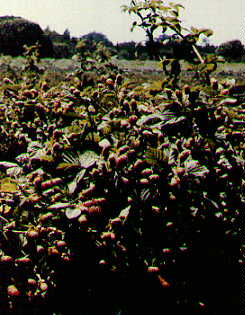
Coastways Berry Harvest and Berry Facts

The Olallie Berry was created by George F. Waldo, who developed the Berry in Oregon. It is a cross between a Blackberry, Loganberry and Youngberry. Although originated in Oregon, it is widely cultivated in California. The Olallie is slightly longer, more slender and has a tangier flavor than the Boysenberry. At maturity, it is glossy black. It has the advantage of a shorter winter chilling requirement than the Boysen, making it more adaptable to much of the California coastal area. It is also completely resistant to verticillium wilt, a soil-borne fungus disease that infects the canes. Therefore no fumigation of the soil is necessary.
The Loganberry apparently resulted from a cross between the California wild Blackberry and the red Antwerp rasberry. Prior to 1920, it was the most popular blackberry in California. The acreage declined rapidly between 1920 and 1930. A virus disease was believed responsible for this decline. Only small plantings of this variety now exist. Coastways has a few of this variety planted among the Olallies in the pasture field. Some customers come just for this special berry.
The Youngberry is quite similar in flavor and appearance as the Boysenberry. The Boysenberry was introduced to the public by Walter Knott of Buena Park, California (Knott's Berry Farm!). It is believed to have originated as a chance seedling in the garden of Rudolf Boysen, for whom it is named. It has been suggested that it was originated by Luther Burbank, as it's similarity to the Youngberry suggests similar parentage, which could have been Burbank's "Phenomenal" variety. Coastways has a few Boysens planted among the Olallies in the old field, near the Kiwis.
Culture of Olalliberries is a year round process. It takes two years to produce a berry! New canes grow the first year, and berries are produced on these canes the second year. Right after harvest the old fruited canes are cut down to the ground and the new growing canes are woven by hand onto the trellis. In the fall, before the rains, manure is applied to the soil as a part of the fertilization. In the spring, as new leaves are sprouting, lime sulfur is sprayed on to prevent a fungus infestation which would severly diminish the quantity of berries produced. Later, near blooming, nitrogen sulfate is sprayed on the leaves as a foliar fertilizing (leaf feeding!). This helps produce sweet berries. There are no pesticides sprayed on the fruit.
Here at Coastways, we grow Olalliberries in two locations; at the pasture field, which is 4 1/2 acres, and at New Year's field (old field), which is 6 1/2 acres. Our average berry production is 4 tons (8,000 pounds) per acre.
Olallieberry plants can often be purchased in local nurseries, usually from October through December, the best times for planting.
For recipes, about a pound of berries will make almost 2 cups of crushed fruit.
The berry harvest time is generally May through July of every year. The start time varies due to spring rains and the start of warm days. In 1997, we began to offer the berries in late May. This year, they were late, but this tracks pretty well with 1982, another serious El Niño year.
Just for your information, here is the recent history of the Berry Season:
Coastways Ranch Berry Season Chart
| YEAR |
OPEN |
CLOSE |
TOTAL DAYS |
| 1998 |
6/13 |
?/? |
?? |
| 1997 |
5/24 |
7/6 |
46 |
| 1996 |
5/25 |
7/16 |
54 |
| 1995 |
6/2 |
7/16 |
44 |
| 1994 |
6/4 |
7/24 |
50 |
| 1993 |
5/23 |
7/12 |
59 |
| 1992 |
5/16 |
7/5 |
50 |
| 1991 |
6/16 |
8/10 |
55 |
| 1990 |
6/9 |
7/22 |
43 |
| 1989 |
6/4 |
7/15 |
43 |
| 1988 |
5/27 |
7/13 |
47 |
| 1982 * |
6/12 |
7/18 |
36 |
| 1981 |
5/30 |
7/12 |
43 |
* 1982 was another El Niño Year like 1998

Please feel free to call for exact harvest times and reservations.
(650) 879-0414
Return to the Coastways Main Page
© 1996, 1997, 1998 Coastways Ranch



